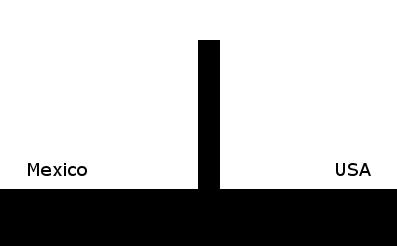Original post:
One nit to pick.
The author exposes his (and The Register's) Britcentric worldview by quoting area in fractions of a "Wales" i.e. "milliWales" when everyone knows the units are a "Manhattan" (22.8 mi²) and a "Rhode Island', conveniently equal to 53.111 Manhattans. Recently there has been a movement to measure iceberg's in Berlin's leading some commenters (Leonard Cohen) to suggest "First we take Manhattan, then we take Berlin".
Rest is fine.
From FT Alphaville:
Clearly, this is nonsense. A complete waste of time. It’s not our intention to suggest the US will pay for its Mexico border wall by putting solar panels along the south side. That’s definitely probably not going to happen. Though comic book supervillains might draft secret plans to harvest daylight from their enemies, the evidence that POTUS is a comic book supervillian is at best circumstantial. What we have here is a hypothetical.
Would it work, though?
Stage I: building a Wall
“What a great idea!” says Doug McKenzie, a solar analyst and consultant, who goes on to explain why it’s a terrible idea. (Doug blogs at lightsonsolar.com: the principles and calculations that follow are mostly referencing off his work. Thanks also to Energy Futurist / Analyst / Writer / Speaker Chris Nelder for trying to guide us through the basics.)
The first thing to note is that the US-Mexico international border is quite long. As in, it runs for 3,200 kilometres. America has a treaty with Mexico to protect the environment for 100km on either side of the border, which might limit the ability to build straight lines across the length of the frontier. And the borderline snakes quite a bit, across all sorts of terrain, in a way that solar farms usually don’t. Such complexity demands ballpark estimates where small changes make big differences. Links are peppered through the text for you to run your own numbers, or to backtest ours.
We’re assuming the Wall needs to be wall-shaped. Whereas solar panels work best when pitched at an angle, there would be obvious downsides to building a ramp. Some solutions have already been proposed involving moats and suchlike, but evaluation of their practicality and cost-benefit is beyond the scope of this analysis.
Here’s the design concept we’ll be using:

How high, though?
The Great Wall of China tops out at six metres high. Trump’s Wall will be Greater, which means it’ll be seven metres high; QED. That gives 22 square kilometres of wallspace. Allowing for 2 square kilometres to be left fallow (maintenance access, border checkpoints etc) leaves a usable area equivalent to a milliWales.
As well as the area we need an azimuth, the horizontal angle at which the sun’s rays hit the Wall.
Panel alignment is a subject not without controversy, as Dr Joshua Rhodes explains in Scientific American, because south-facing will maximise output while west is preferable for catching peak demand. Fortunately, the Mexico side of the US border faces both south and west in parts, so should offer a convenient balance between efficiency and timeliness....MORE, so much moreUpdate:
Continuing to stand on the shoulders of giants (Register readers) one suggestion is: if we are to use Wales as our unit source why not go with the town of
Llanfairpwllgwyngyllgogerychwyrndrobwllllantysiliogogogochas the measure of area?
Among other admirable qualities, it won't be easily confused with those Eurofied square meters or hectares. Here's the weatherman's pronunciation guide: